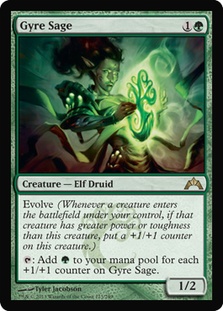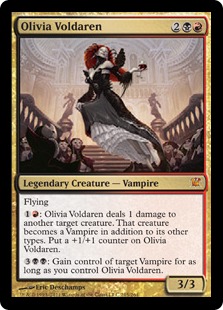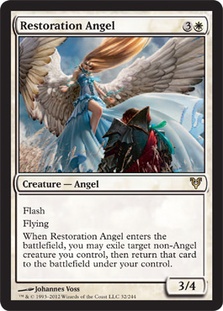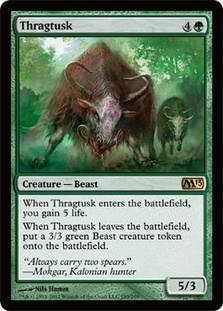Two households, both alike in dignity,
In fair Verona, where we lay our scene,
From ancient grudge break to new mutiny,
Where civil blood makes civil hands unclean.
That’s the place from which I’m writing now—Verona, the ancient Italian city made famous by Shakespeare’s excellent tragedy. This is also the location of a Grand Prix, so this article is the first in my short series of travel updates from Europe, where I’m spending my vacation sightseeing and participating in Grand Prix. GP Verona didn’t go well for me, and I still don’t have a team for GP Utrecht. But at least I’ve learned some lessons that I can share with my readers—and I’m not talking about the wonderful sightseeing (I’m not very good at actually playing Magic, but I’m very good at sightseeing and like history). So this and probably the next two articles will combine Magic musings and ideas with travel anecdotes and impressions from new places.
Magic should come first, so the first lesson I’ve learned is to pay more attention to details and numbers. My team and I tested and tuned my deck for GP Verona a lot. We figured out its most important problem, but even after that we underestimated it, which influenced the final result in very sad way. In my last article, I highlighted Jund Aggro with Gyre Sage as the two-drop of choice, and I decided to play this deck at the GP. Unfortunately, extensive testing repeatedly came to the following dialogue:
- What to sideboard in this matchup?
- Card X, card Y, and two more cards—don’t really know which ones.
- Hmmm, maybe Gyre Sage?
I dislike Mogg Flunkies, but I finally decided to discard the idea of having both Experiment One and Gyre Sage in this deck. It’s always hard to throw a pet card in the bin, but sometimes it has to be done. I thought about putting Strangleroot Geist in this slot, but even if my mana base with four basic Forests and Arbor Elfs were friendly to this idea, Ari Lax correctly identified that the first half of Geist isn’t worth a card.
Gyre Sage was great in testing when it got on the board in time and in proper quantities, but it significantly increased the variance of starting hand quality, making many otherwise aggressive hands much less attractive, and decreased the quality of midgame topdecks in the crucial moment when it’s important to topdeck a reasonable body to win before the opponent stabilizes. So although I’d like to play both Gyre Sage and Experiment One in the same deck, it shouldn’t be Jund Aggro.
The two most important problems we didn’t solve ultimately cost me matches. The first one was that Jund Aggro is much worse when the opponent goes first—it’s not always crucial since the opponent may have a slow draw, but it looks much more important. My statistics from the GP shows that seven of my nine matches ended 2-1, and, more importantly, I won two-thirds of games when my turn I went first and lost two-thirds of games where I was on the draw.
It’s obviously possible to improve this situation because some of my losses were due to mistakes on my part, but the tendency is clear. Something needs to be done to make the deck a serious contender in Standard and to cure the typical Mono-Red Aggro problem of having not enough gas to break out of the opponent’s defense. Jund Aggro has much better creature quality than Mono-Red, but we’re talking about a format with Thragtusk and Restoration Angel.
The second important problem was that Jund Aggro doesn’t mulligan well. Its nut draws are fast and furious, but they are not very frequent. Most of the time you have to gamble, hoping to draw the proper card in one or two draw steps, or mulligan, hoping to draw a better six cards. Honestly, both are very loose. I gambled in my last rounds (when I was out of day 2 contention), and the results were predictable. Sometimes the gamble paid off, and sometimes it didn’t—statistics is hard to deceive.
Mulliganing may have worked better if I’d paid more attention, but this problem was underestimated in testing. In the Grand Prix, I mulliganed nine times in the first four rounds; I may have just been unlucky, or it may have been a personal problem since I tend to mulligan aggressively. I think it would’ve been better if I’d paid more attention to mulliganing with this deck in testing. I’m not sure if I’ll play the same deck in upcoming Standard tournaments, but it’s still interesting and may do better in the hands of a better-prepared pilot. The most recent list I have is the following:
Creatures (30)
- 3 Mogg Flunkies
- 3 Arbor Elf
- 4 Falkenrath Aristocrat
- 4 Flinthoof Boar
- 4 Dreg Mangler
- 4 Burning-Tree Emissary
- 4 Experiment One
- 4 Ghor-Clan Rampager
Lands (22)
Spells (8)

I prefer Arbor Elf to Rakdos Cackler because solving mana screw problems is more important in this deck than attacking for two once. Moreover, I actually want to scavenge Dreg Mangler and from time to time even flashback Sever the Bloodline, which proved itself a great maindeck addition and very versatile spell. The sideboard contains removal, Vampire Nighthawk, and Olivia Voldaren for aggressive decks and Duress and Garruk Relentless for control decks. One or two Kessig Wolf Run is usually sided in against both since decks tend to become more controlling when facing an aggro deck.
An interesting note: I didn’t explore this idea in detail, but the instability of the current list may be solved by making the post-board anti-aggro list our maindeck. Against aggro, you typically sideboard like this: -4 Mogg Flunkies, -4 Burning-Tree Emissary, -4 Rakdos Cackler (if you have it), + all removal and Olivia. With this the deck becomes more midrange Jund, which has good aggressive matchups, but it is still much faster and has less of a problem drawing the proper half of the deck for the matchup.
Jund Aggro has variance problems with starting hands, but it generally draws better because the cards in your deck are more predictable. Making a heavier aggro version will obviously work better in an aggressive metagame, which isn’t expected in the near future, but if such a hybrid can play reasonably well against control decks, it will deserve its place in the sun—which poor attendees of GP Verona didn’t, as it was cloudy and rainy in Verona between Wednesday and Saturday.
Maybe I didn’t pay enough attention, but the fact that an umbrella may be good to have on vacations in the southern country in spring is actually surprising to me. I really hoped to experience a piece of spring after a long Russian winter, but after an hour in Milan I was so cold and weary that I found the Ukrainian team in my coach two minutes before we arrived in Verona. They weren’t in much better condition than I, so instead of a long sightseeing session and quick testing session, our evening quickly became a bar testing sessions since there was nothing else to do here.
We tested the local wines and matchups of U/W/R, Jund Aggro, and Human Reanimator. The local wines obviously won by a wide margin, but we also had some useful results as three of the five of us are fighting in day 2 right now, also featuring Mike Krasnitski and Alex “DrVendigo” Onosov fighting for the Ukrainian National Champion title.
The most important conclusions we made both concerned Reanimator. The first one was about Jund Aggro. You may have noticed that despite great quantities of the two kinds of Reanimator in GP Verona coverage, I didn’t put any graveyard hate in the deck’s sideboard. Moreover, the only side in for this matchup is a removal upgrade. That’s obviously because the matchup is very good for Jund Aggro; we didn’t break it, but one interesting point was found.
When we came to post-board testing, Mike sided out all of the combo and sided in a pack of value creatures—Thragtusk, Restoration Angel, and Centaur Healer—becoming a bad but still powerful midrange deck. However, Jund Aggro is supposed to beat bad midrange decks, so the matchup became even more horrible than it was. We analyzed the games we played before and after sideboarding and came to an interesting conclusion: Reanimator also shouldn’t sideboard in this matchup since its only chance to win is to assemble the combo quickly. Sideboarding into a midrange deck is inevitable against powerful graveyard hate and may work against other aggressive decks, but Jund Aggro has a bunch of hasty threats so it’s almost impossible to stabilize and then win the topdeck war.
From the Jund Aggro perspective, game 1 is losable as an early Fiend Hunter may slow down our aggression and allow the opponent combo before they can lose, but post-board games are much simpler because there is no need to play around the potential of a sudden combo. My match against Reanimator in the GP went like this. Game 1 my opponent assembled the combo at one life; games 2 and 3 he lost because he didn’t have the combo in his deck. An interesting moment occurred in the last two turns of the match and of the very long game where both my opponent and I drew infinite lands (I flashbacked Sever the Bloodline in that game to prevent Fiend Hunter from killing me).
I played around Restoration Angel, which my opponent correctly didn’t have in his deck. Reverse sideboarding is very expensive in terms of sideboard slot wasting, and Rhox Faithmender is much more dreadful for aggro decks—you can’t have both. Restoration Angel is good against decks like U/W/R, but having a sideboard for worse matchups is generally better than for good ones. So despite the fact that I said that Humans Reanimator shouldn’t sideboard at all against aggressive decks and that it’s impossible to have both Rhox Faithmender and Restoration Angel, the correct plan seems to be following: side in only Rhox Faithmender against aggressive decks and play to try to assemble the early combo. Have Restoration Angel / Thragtusk against U/W/R, Jund, and other decks with graveyard hate.
Our Jund versus Reanimator playtesting session ended abruptly when the coffee house we were testing at closed. When we started packing our cards, the waitress, who didn’t know any English, gestured at our cards and at the window, and when I looked I saw a big Magic: The Gathering banner ten meters from where we were. We’d found a local shop. Unfortunately, there was nothing there to warm us after a long, cold, and rainy evening, so we proceeded to a pizzeria to test Reanimator against U/W/R and to test the local pizza and wine. I probably would have stuck just to pizza, but my train from Milan to Verona had made its way through endless vineyards, so tasting the local wine was inevitable and ended up being very, very good.
Returning to U/W/R versus Reanimator, the graveyard is favored here, and all our U/W/R pilots decided to have three Tormod’s Crypts to help. However, it didn’t help much, but we realized that Crypt helps win when U/W/R is able to provide pressure. Many games won by U/W/R were ended with Harvest Pyre, so we quickly realized that the most promising strategy is to side in Jace, Memory Adept to mill yourself, simultaneously providing card advantage and assembling a giant Harvest Pyre. Thought Scour made nearly the same work cheaper, but Jace was also good.
The breakthrough came when Denis accidentally tried Geist of Saint Traft. He was displeased a card and wanted to side it out. “Okay, let’s see if the Spirit will work.” Flame Javelin for 1UW was surprisingly helpful. Ultimately, the matchup didn’t become positive for U/W/R, but it improved from nearly unwinnable. Ukrainian player Oleksandr Onosov is on camera in GP Verona coverage right now, so I’m going to finish my travel update and go to the tournament site to root for Russian-speaking players in contention for Top 8.





